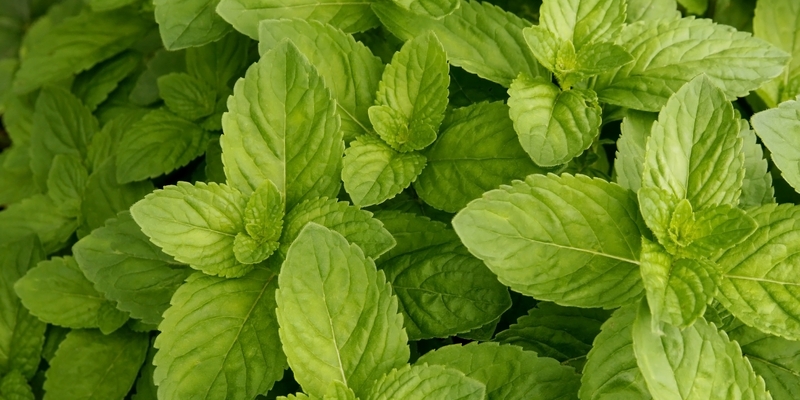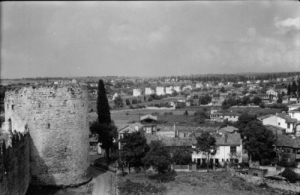Mint, nane, is indigenous to the Mediterranean region and has been flavoring Turkish cuisine for centuries. Used to treat skin ailments by the ancient Romans and in funerary rites by the Greeks, the well known herb derives its English name from the ancient Greek mythical river nymph, Minthe. Associated with the river Cocytus, Minthe was punished for attempting to seduce Hades by his queen Persephone. Persephone turned Minthe into a plant so that everyone would walk all over her, crushing her for eternity. Hades, who had fallen in love with Minthe, was unable to undo the curse and in atonement gave her a pungent and sweet smelling aroma.
Mint’s lamiaceae family of perennial herbs contains at least twenty-five different species of mentha including rosemary, thyme, oregano, peppermint, and spearmint. If cultivated from its own regenerating root-stock and if there has not been any introduction of foreign seeds, the specific nane in the Yedikule gardens has likely been grown for generations. Spearmint is the preferred mint used for cooking. It is bright green, low growing plant with a square stem and jagged edged leaves that can be variegated and fuzzy. Both fresh and dried mint leaves and stems can be used for many different culinary and pharmaceutical purposes, but fresh leaves are usually preferred.
Although it is not highly aggressive, mint’s tendency to grow unchecked have led some to label it invasive. Accordingly, growing mint is relatively low-maintenance. Wet environments and loamy, moist soils are considered best, and full sunlight is ideal. To grow outdoors one or two cuttings should be planted about two feet apart, and it should grow to be about one to two feet tall. Mint is susceptible to a few pests and diseases including powdery mildew, rust, and anthracnose.
The Byzantine gardening manual Geoponika, includes a short discussion on mint in Book Twelve in which it “is thought to have no use.” A further examination of the text, however, reveals its many uses. Mint aids in vegetable and herb preservation, prevents “must” from overflowing in its storage vats and milk from curdling, promotes digestion, and repels pests. This ancient farming guide confirms the herb’s cultivation practices in its description.
It likes temperate, dry air and a sunny site not shaded by trees. It grows underground and spreads. It is sown and planted. If sown it is harvested only in the third year, but if one plants the top of the root (the eye as some call it) from which the shoots grow, it can be harvested in the same year.
The text’s description of growing techniques for mint and its superficial applications indicate that there was a wide variety of uses for the herb.
The mint grown in the Yedikule bostans has smaller leaves that are bright green and smooth, but not fuzzy. Its taste is sharp with a cooling aftertaste and the plant smells minty while it grows before being harvested or crushed. Spearmint is the most common form of mint used for seasoning and is traditionally used in Turkish cuisine with yogurt in sauces and soups. The recipe for lentil and mint “Ezo Gelin Çorbası” or Soup of Ezo the Bride conjures nostalgia for a the beauty, aromas, and flavors of the Mediterranean in the midst of a gloomy winter afternoon. According to legend the recipe is remembered from the folk tales and songs of the young Ezo who died of a broken heart after marrying a man in Syria and leaving her homeland to join him. Her soup cures homesickness and reminds one to embrace past and future adventures.
Ezo Gelin Çorbası – Food Blog and the Dog
Ingredients
- 2 tbsp olive oil
- 1 onion, finely chopped
- 1 carrot, finely diced
- 1 stick celery, finely chopped
- 3 or 4 cloves garlic, finely chopped
- 1 tbsp paprika
- 1 tsp cumin seeds
- 1/4 tsp dried chili flakes
- 1/4 tsp cayenne pepper
- 3 tbsp tomate frito (tomato paste)
- 1 tomato, chopped
- 1 tbsp dried mint
- 150 gr (1 cup) dried lentils, red lentils if possible
- 50 gr (1/4 cup) wholegrain rice
- 50 gr (1/4 cup) quinoa or bulgur wheat
- about 1 1/2 litres veg stock (or a mix of water & stock)
- 1 tbsp sumac (optional)
- salt & black pepper
- fresh mint leaves, chopped for garnish
- sumac for garnish (optional)
- lemon wedges, to serve
Directions
Heat the olive oil in a large soup pot over a medium heat. Cook the onions, carrots & celery with a pinch of salt for 4 or 5 minutes until softened and lightly golden. Then add the garlic, cumin seeds, paprika, chili flakes, cayenne, tomato & tomato paste and cook for a further 5 minutes
Add in the lentils, rice & quinoa (or bulgur wheat) and stir to coat in the tomatoey spices. Add the veg stock/water, season well with salt & black pepper, add the dried mint and bring to the boil. Turn the heat down, cover and simmer for 35-40 minutes everything is tender.
If you like you can remove a ladleful of the soup and blend it until smooth, then add it back into the soup. This gives it a smoother thicker consistency. Add the sumac, taste for seasoning, add more salt or mint if necessary. Bring back to the boil.
Serve in warm bowls sprinkled with chopped fresh mint leaves, a little sumac and some lemon wedges to squeeze over.






